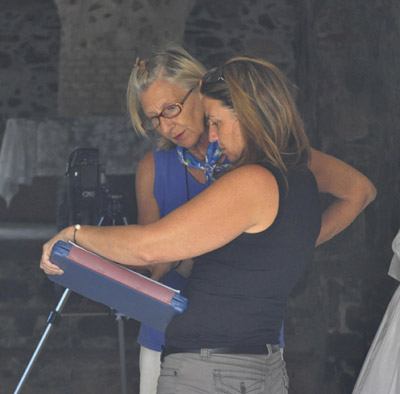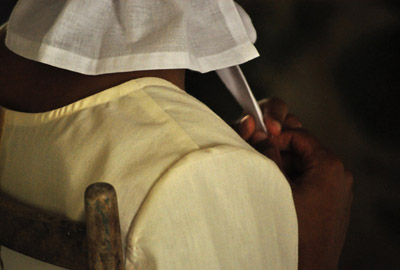
News
August 2013
Every Era All at Once: On the Set of Janet Cook-Rutnik's "Crime Seen"
by David Knight Jr. ARC Magazine — August 20, 2013
Source: arcthemagazine.com
When I ask Janet Cook-Rutnik to tell me a little bit about her background, she begins like this: “In 1969, the day Neil Armstrong set foot on the moon, I landed in the Virgin Islands ready to begin my real life.” I admire the gift for storytelling she displays by pairing those two images of uncertain arrival. And there's something else striking about that sentence. There are a lot of expatriates in the Caribbean who have a habit of framing their life stories as an escape from “real life” or “the real world”. In Cook-Rutnik';s personal narrative, she's on an opposite trajectory. I like that.

Janet Cook-Rutnik on set of "Crime Scene".
All photographs courtesy of the artist.

Kayla Clendinen on the set of "Crime Seen."
In the four decades since she arrived in the U.S. Virgin Islands, Cook-Rutnik has established herself as one of the territory's most prolific artists, first as a sculptor and a painter, and more recently in the realm of video and installation art. Since 2003, she has been collaborating with several artists and scholars on a collection of pieces called The Transfer Project. In 2017, The U.S. Virgin Islands will commemorate the 100th anniversary of transfer from Denmark to the United States, and the purpose of The Transfer Project is to inspire reflection on “the possibilities and the losses” that are woven into the last century. Often the theme of the project has been migration — the constant flow of people in and out of these islands since Transfer, the threads that connect us to the rest of the region, the U.S. mainland, and beyond. “In considering issues of relevance to the Caribbean and the small islands within it, migration seems the most profound and constant fact of life,” Cook-Rutnik says. It may also be the hardest fact of life for us see with clarity, not only because it has bred such endless diversity of experience, but also because it demands a stance of total compassion, an embrace of what makes us least secure.
Cook-Rutnik's newest project, entitled “Crime Seen”, is a shift in focus. While previous works in The Transfer Project have focused mostly on the turn of the 20th-century, this latest installment is firmly planted in the Danish colonial era, and specifically the world of the sugar plantation. This is perhaps a controversial change in direction, but Cook-Rutnik insists that her work remains reflective rather than dogmatic. “Because contemporary art is conceptual, cerebral, addressing social issues, it has become a new form of ‘knowledge production’, but my work is not intended to educate, but rather to stimulate thought. I'm trying to raise questions rather than make statements. The fact is that no one is interested in rehashing the past — colonial history is very complex, its imagery is rich and brutal — it is the often unacknowledged foundation of the economic world we live in — all the seeds of justice and injustice, wealth and poverty were sown during this pivotal transition from the old world to the new.”
See more at:
http://arcthemagazine.com/arc/2013/08/every-era-all-at-once-on-the-set-of-janet-cook-rutniks-crime-seen/
September 2012

